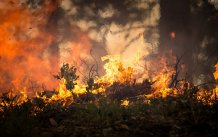Articles

Fire weather refers to periods with a high fire risk due to a combination of high temperatures, low humidity, low rainfall and often high winds.
New research strengthens evidence for climate change increasing risk of wildfires
New scientific publications reviewed since January 2020 strengthen the evidence that climate change increases the frequency and/or severity of fire weather in many regions of the world.
Published today at ScienceBrief.org, the updated review on the link between climate change and risks of wildfires focuses on articles relevant to the fires ongoing in the western United States, new findings relevant to the southeastern Australian wildfires that raged during the 2019-2020 season, and new findings published since an initial review of research was conducted in January 2020.
The ScienceBrief Review in January looked at 57 peer-reviewed papers on the link between climate change and wildfire risk published since the IPCC's Fifth Assessment Report in 2013.
The update, led by Dr Matthew Jones of the Tyndall Centre for Climate Change Research at the University of East Anglia (UEA), covers 116 scientific articles.
It involved researchers from UEA, the University of California, the Commonwealth Scientific and Industrial Research Organisation (CSIRO), the Met Office Hadley Centre and the University of Exeter.
Fire weather refers to periods with a high fire risk due to a combination of high temperatures, low humidity, low rainfall and often high winds.
The western US is among the regions where the trends in fire weather have been most pronounced in the past at least 40 years.
Fire activity is influenced by a range of other factors including land management practices.
However, the authors say land management alone cannot explain recent increases in wildfire extent and intensity in the western US or southeast Australia because increased fire weather from climate change amplifies fire risk where fuels remain available.
Dr Jones, a senior research associate, said: “The western US is a hot spot for increases in fire weather caused by climate change, and it is completely unsurprising that wildfires are becoming more frequent and intense in the region.
“The western US is now more exposed to fire risks than it was before humans began altering the global climate by using fossil energy on a grand scale. Regardless of the ignition source, warmer, drier forests are primed to burn more regularly than they were in the past.
“Climate models indicate that fire weather will continue to rise this century in many parts of the world, and increasingly so for each added degree of global warming. A switch to an economy supported by renewable energy sources is needed to avoid the worst impacts of climate change on fire risk.”
Professor Richard Betts, of the University of Exeter and the Met Office Hadley Centre, said: “By heating up the world’s climate, we are making hot, dry weather more likely, which increases the risk of fire.
"While other factors like land management also play a role, they are not the whole story by any means, and climate change is also a big influence – hot, dry conditions make fires more intense and spread faster.”
Key messages from the new analysis:
- More than 100 studies published since 2013 show strong consensus that climate change promotes the weather conditions on which wildfires depend, increasing their likelihood.
- Natural variability is superimposed on the increasingly warm and dry background conditions resulting from climate change, leading to more extreme fires and more extreme fire seasons.
- Land management can enhance or compound climate-driven changes in wildfire risk, either through fuel reductions or fuel accumulation as unintended by-product of fire suppression. Fire suppression efforts are made more difficult by climate change.
- There is an unequivocal and pervasive role of climate change in increasing the intensity and length in which fire weather occurs; land management is likely to have contributed too, but does not alone account for recent increases in wildfire extent and severity in the western US and in southeast Australia.
The original literature review and the update were carried out using the new ScienceBrief online platform, set up by researchers at UEA and the Tyndall Centre. Written by scientists, it helps make sense of peer-reviewed publications and keep up with science. ScienceBrief Reviews support transparent, continuous, and rapid reviews of current knowledge.
'Climate Change Increases the Risk of Wildfires' (ScienceBrief Review September 2020 update), Adam J P Smith, Matthew W Jones, John T Abatzoglou, Josep G Canadell, Richard A Betts, is published at ScienceBrief.org on September 25.
Date: 25 September 2020
